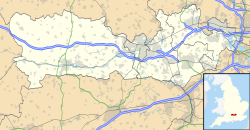| Bradfield | |
|---|---|
| Village | |
 The River Pang in Bradfield village | |
Location within Berkshire | |
| Area | 16.67 km2 (6.44 sq mi) |
| Population | 2,208 (2021 Census) |
| • Density | 132/km2 (340/sq mi) |
| OS grid reference | SU6073 |
| Civil parish |
|
| Unitary authority | |
| Ceremonial county | |
| Region | |
| Country | England |
| Sovereign state | United Kingdom |
| Post town | Reading |
| Postcode district | RG7 |
| Dialling code | 0118 |
| Police | Thames Valley |
| Fire | Royal Berkshire |
| Ambulance | South Central |
| UK Parliament | |
Bradfield is a village and civil parish in Berkshire, England. At the 2021 census, the parish had a population of 2,208, which was slightly more than the 2,177 recorded at the 2011 census. [1] Aside from farms and a smaller amount of woodland its main settlements are Bradfield Southend, its medieval-founded nucleus and the hamlet of Tutts Clump. Bradfield village is the home of the public school Bradfield College.


